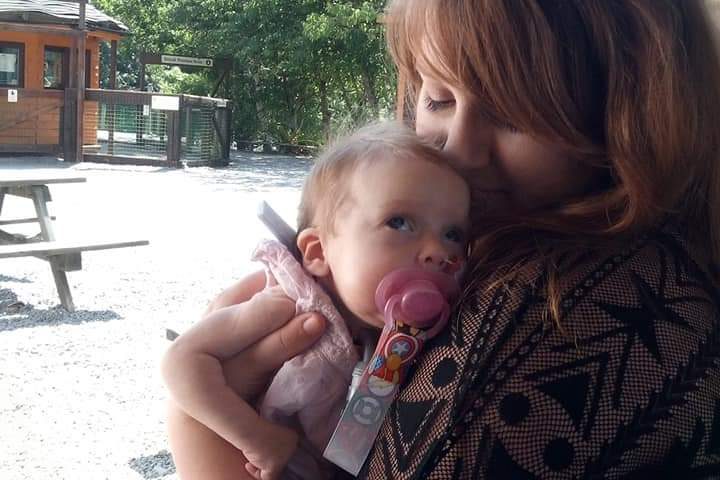Note: This story was updated Nov. 10, 2020, to clarify that Foggin volunteers with the International Gaucher Alliance and does not hold a formal position with Prevail. In addition, the story has been corrected to note that the same PR001 gene therapy is being tested in both Gaucher and Parkinson’s diseases.
Carly Foggin knew something was wrong with her first child, Harper, as soon as the newborn gave a cry: a high-pitched squeak instead of a wail.
Weeks later, the new mom would perform CPR on Harper after the baby stopped breathing during feeding in a successful attempt to keep her alive.
Today, Foggin, 22, who lives in the port town of Blyth, England, is working to keep other Gaucher babies alive, in part by volunteering with the International Gaucher Alliance (IGA) on behalf of other families facing a Gaucher diagnosis and in part by sharing her family’s story to raise disease awareness.

She and her husband, Connor, went through two false diagnoses until doctors got to the bottom of what was going on with Harper, then 5 months old: type 2 Gaucher disease, a rare genetic and progressive disease in which waste products build in cells, damaging the brain and other organs. They would be lucky if she lived another two months, the doctors said.
“When they gave us the diagnosis, it took us a couple of minutes to process what was said and allow myself to breathe for a couple of moments,” Foggin said. “The next thought that came through my head was this condition is not going to steal all of those memories from my daughter.”
Foggin started jotting down a bucket list for her infant. Harper would be an integral part of her parents’ wedding, and celebrate her first birthday. She would go to the beach, meet the Gruffalo (a children’s book character), delight in nature, and celebrate every major holiday — all in a span of a couple of months.
The extra planning was well worth it.
“You knew fine well how hard you’d work to get a smile out of her. She eventually did smile, and it was just such a glorious, nice moment when she would,” Foggin told Gaucher Disease News in a Zoom interview. “I remember hearing her laugh for the first time, and I worked so hard to get that laugh from her.”
Because of the neurological damage caused by her disease, Harper’s eyes were fixed upward. Toward the end of her life, she also lost the ability to visually track objects. Her eyebrows were always her most expressive feature, her mother said.
Foggin remembers as absolute nirvana Harper’s reaction to butterflies whooshing past her face during a visit to a sanctuary in Manchester.
“This magical look [came] on her face, like ‘Wow! What is going on?’” Foggin said.
While the family stayed at a hotel near Harper’s doctors, she also had a chance to try ice cream — another box checked on that long bucket list.
“As soon as the cold ice cream and sugar went into her mouth, I could see the look on her face,” Foggin said. “It was magic.”
Carly and Connor Foggin packed Halloween and Christmas into two October days, choreographing a handful of costume and apparel changes for Harper. Doctors had told the parents on their “Christmas” Sunday that Harper would soon die. She made it another week, until Oct. 11, 2018.
“Even if it was eight months, she was going to have a lifetime worth of memories,” Foggin said. “She might have moments where she couldn’t breathe and was struggling, and I felt guilty as hell. But I would just look at her and be like: ‘You know what though, she’s perfection and deserves the world and that’s exactly what I’m going to give her.’ ”
Over the three months that followed her diagnosis, Harper — born Feb. 15, 2018 — packed in years of adventure with the help of her parents.
Foggin is now determined to use her experiences to help other parents, wherever they might live, who have a child with Gaucher disease.
“I try to do as much as I can for advocacy because I’m telling Harper’s story. I’m spreading it far and wide,” she said, adding that Harper is known across every continent. “The more I talk about her, the more alive she feels.”
“I want Harper’s story to be told, but also I want families that are in mine and Connor’s shoes, who have had a child recently diagnosed with type 1, type 2 or type 3 [disease] — who feel like because it’s so rare, they are on their own — I want them to know that there is hope.”
The Foggins recently celebrated the two-year anniversary of Harper’s death, which falls on the same month as Gaucher Disease Awareness Month. Her mother also advocates for a potential disease-modifying treatment — a possible first targeted treatment for Gaucher type 2 — through her volunteer work at IGA.
Prevail Therapeutics is developing a gene therapy called PR001 for type 2 patients. It recently received fast track designation from the U.S. Food and Drug Administration, in addition to rare pediatric disease and orphan drug designations, all designed to support and speed the therapy’s development.
Prevail is sponsoring a Phase 1/2 clinical trial (NCT04411654) testing the safety and efficacy of a single treatment with PR001. The trial, to be conducted at four centers across the U.S., is now enrolling 15 type 2 newborns and toddlers up to age 2; contact and site information can be found here.
PR001 showed promise in animal studies, and a few patients have already been treated under a compassionate use program, which takes into consideration the lack of treatments available for Gaucher type 2 and its progressive nature, said Asa Abeliovich, MD, PhD, Prevail’s CEO and co-founder.
“Some of the [damaging] changes that can be seen in the brain in these animals could be reversed,” Abeliovich said. “That gave us a great deal of confidence and opportunity here to really help.”
Type 1 Gaucher patients benefit from enzyme replacement therapy, but enzymes are unable to be carried by the blood into the brain to treat the neurological nature of type 2 disease. Prevail’s gene therapy, which uses an adeno-associated virus (AAV9) as a transporter, can cross that barrier. It uses the harmless AAV9 to deliver a healthy copy of the GBA gene, whose mutations cause Gaucher, to cells in a patient’s brain.
Clinical trial achievements with a gene therapy for spinal muscular atrophy, approved in 2019 as Zolgensma by Novartis, inspired Abeliovich to start Prevail in 2017 and begin developing PR001 to treat neuropathic Gaucher, and Parkinson’s disease patients with GBA1 mutations. A Phase 1/2 trial (NCT04127578) of the gene therapy is underway and recruiting adults with moderate to severe Parkinson’s in the U.S.
“We saw this opportunity to develop drugs that we think could, even in the near term, help patients,” Abeliovich said.
Enrollment for the Gaucher type 2 trial, called PROVIDE, requires a genetic test to determine that a patient’s mutations would be amenable to PR001, given as a one-time intracisternal injection, or an injection directly into the cisterna magna, an area above the spinal canal containing spinal fluid.
While years will likely pass before this gene therapy’s potential is established, for Foggin, any gain realized is a win.
“Type 2 has never had that type of opportunity. It provides [patients] with hope and the potential to have even an extra week or an extra month,” Foggin said. “Any extra time is a lifetime.”


